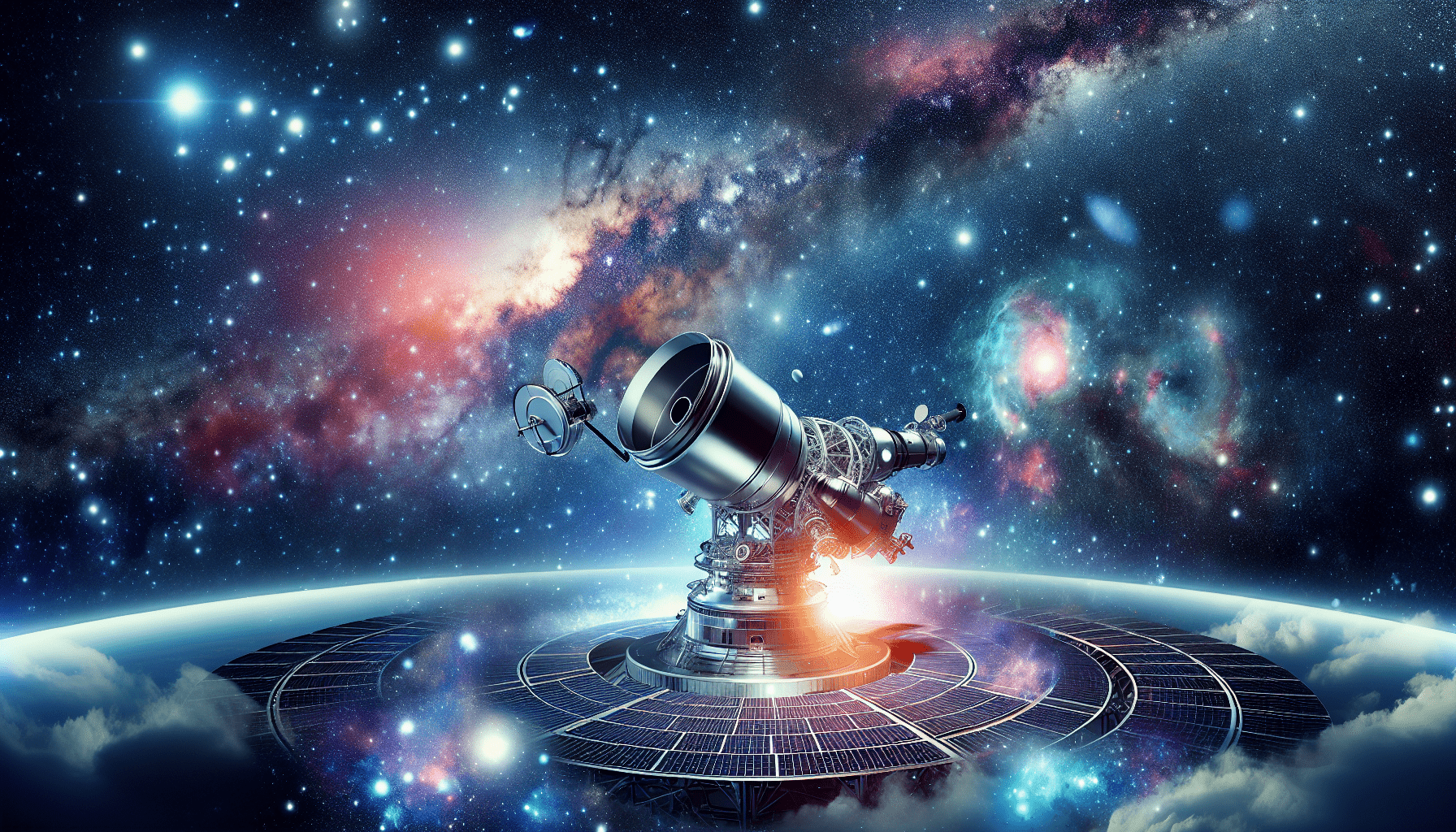The article “Exploring the Vast Universe with Telescopes” delves into the transformative history and current advancements in astronomical observation, tracing the evolution from early rudimentary instruments to sophisticated, state-of-the-art telescopes. It examines key milestones and significant figures in this enduring quest to gaze deeper into the cosmos, revealing the intricate workings and breathtaking beauty of our universe.
Highlighting recent trends and technological breakthroughs, the article discusses the enhanced capabilities of modern telescopes, such as the Hubble Space Telescope and the more recent James Webb Space Telescope, which continue to revolutionize our understanding of the cosmos. By detailing both historical context and contemporary developments, the article presents a comprehensive and insightful exploration into the pivotal role telescopes play in expanding human knowledge of the universe. What lies beyond our blue sky, and how can we explore the vast mysteries of the universe without ever leaving Earth? These questions have captivated humanity for centuries, driving the quest for knowledge and exploration. One of the most powerful tools in this endeavor is the telescope.

This image is property of pixabay.com.
Table of Contents
Overview
Telescopes are instruments that have revolutionized our understanding of the cosmos. They allow us to peer into the night sky, reveal the intricate details of our Solar System, and probe the farthest reaches of the universe. Their importance in the realm of astronomy cannot be overstated. Whether it is revealing the rings of Saturn or uncovering distant galaxies, telescopes provide invaluable insights into the workings of the universe.
Thesis Statement
This article seeks to explore the profound impact of telescopes on our understanding of the universe, from their historical development to current advances, ultimately demonstrating their essential role in both scientific discovery and societal advancement.
Exploring the Vast Universe with Telescopes
Historical Context
The story of the telescope begins in the early 17th century with the invention of the optical telescope. The first practical telescopes were refracting telescopes, which used lenses to magnify distant objects. Hans Lippershey, a Dutch spectacle maker, is often credited with inventing the telescope in 1608. However, it was Galileo Galilei who improved upon the design and used it to make groundbreaking astronomical observations, such as discovering the four largest moons of Jupiter and the phases of Venus. These observations provided compelling evidence for the heliocentric model of the solar system, challenging the prevailing geocentric view.
Subsequent developments in telescope technology include the invention of the reflecting telescope by Sir Isaac Newton in 1668. Newton’s design used mirrors instead of lenses, resolving issues with chromatic aberration and allowing for larger telescopes capable of capturing more light and providing clearer images.
Historical Milestones
| Year | Milestone | Contributions |
|---|---|---|
| 1608 | Invention by Hans Lippershey | Initial design of the refracting telescope |
| 1609 | Galileo’s improvements and observations | Establishing foundations of modern astronomy |
| 1668 | Newton’s reflecting telescope | Enhanced image clarity and size capability |
| 1789 | William Herschel’s large reflecting telescope | Discovery of Uranus and deeper space objects |
| 1990 | Launch of the Hubble Space Telescope | High-resolution images and deep-space exploration |
Current Trends
In contemporary astronomy, telescopes have evolved to encompass a variety of designs and purposes, from ground-based observatories to space telescopes. Current trends in telescope technology focus on increasing resolution, sensitivity, and range to capture more detailed images of the universe. For instance, adaptive optics systems in ground-based telescopes mitigate atmospheric distortion, while space telescopes like the Hubble Space Telescope avoid these distortions altogether by operating outside Earth’s atmosphere.
Moreover, the development of radio telescopes has enabled the observation of non-visible wavelengths of light, revealing phenomena such as cosmic microwave background radiation and pulsars. The integration of artificial intelligence to analyze vast amounts of data collected by telescopes marks the forefront of current trends, offering unprecedented insight into the universe.

This image is property of pixabay.com.
Key Concepts and Definitions
Telescope
An optical instrument designed to make distant objects appear nearer, using different combinations of lenses or mirrors to magnify the image.
Refracting Telescope
Utilizes lenses to collect and focus light, often suffering from chromatic aberration but historically significant in early astronomical observations.
Reflecting Telescope
Employs mirrors to gather and focus light, allowing for larger apertures and resolving power than refracting telescopes.
Adaptive Optics
Technology that adjusts the telescope’s optics in real-time to compensate for atmospheric disturbances, enhancing image clarity.
Space Telescope
A telescope that operates in space, free from atmospheric distortion, enabling high-resolution observations of the universe.
Detailed Exploration
Telescopes can be categorized into several types, each with unique designs and applications:
Optical Telescopes
Refracting Telescopes
These telescopes use converging lenses to gather and focus light. While they were the first telescopes invented, their large lenses can be difficult to manufacture, and they often suffer from chromatic aberration. Nevertheless, they played a crucial role in early astronomical discoveries.
Reflecting Telescopes
Invented by Sir Isaac Newton, reflecting telescopes use mirrors to focus light. This design allows for larger telescopic apertures and reduces chromatic aberration, leading to clearer images of celestial objects. The largest optical telescopes currently in operation are primarily reflecting telescopes.
Radio Telescopes
Radio telescopes detect radio waves from celestial sources, revealing information that optical telescopes cannot. For example, they have uncovered phenomena like pulsars and cosmic microwave background radiation. The Arecibo Observatory and the Very Large Array are notable examples of radio telescopes that have made significant contributions to our understanding of the universe.
Space Telescopes
Operating outside the Earth’s atmosphere, space telescopes like the Hubble Space Telescope and the James Webb Space Telescope provide unparalleled clarity and range. They avoid atmospheric distortion and light pollution, enabling astronomers to observe distant galaxies, star formation, and other phenomena that are invisible from the ground.
Adaptive Optics
Adaptive optics systems are employed in ground-based telescopes to counteract the blurring effects of Earth’s atmosphere. By using deformable mirrors that adjust in real-time, these systems can produce images with greatly improved resolution, comparable to those from space telescopes.
Examples in Detail
Hubble Space Telescope
Launched in 1990, the Hubble Space Telescope has revolutionized our understanding of the universe. It has captured high-resolution images of galaxies, nebulae, and deep space objects, leading to countless discoveries. For instance, the Hubble Deep Field images provided a glimpse of some of the most distant galaxies, helping to refine models of the universe’s expansion.
Arecibo Observatory
Although recently decommissioned, the Arecibo Observatory was a massive radio telescope that made numerous significant discoveries, including the first binary pulsar. It provided valuable data on planetary science, the ionosphere, and deep-space phenomena over its decades of operation.

This image is property of pixabay.com.
Comparison of Different Perspectives
different types of telescopes offer varied perspectives on the universe, each with unique strengths and limitations. Optical telescopes provide images across the visible spectrum, enabling detailed observations of celestial objects. However, their limitations include susceptibility to atmospheric distortion and light pollution.
In contrast, radio telescopes can observe the universe in wavelengths invisible to the human eye. They capture data on celestial phenomena that emit radio waves, revealing details that optical telescopes cannot. Despite this, they require significant space for their arrays and can be limited by terrestrial radio interference.
Space telescopes offer a solution to atmospheric issues, providing high-resolution images without distortion. However, they are costly to launch and maintain and come with technical challenges such as the need for meticulously planned repairs and upgrades.
Impact Assessment
While each type of telescope offers distinct advantages, the integration of their observations provides a comprehensive understanding of the universe. For example, combining optical and radio telescope data can reveal a fuller picture of star formation and galaxy behavior. Adaptive optics and space telescopes further enhance this understanding by providing ultra-clear and detailed images of celestial events.
Future Directions and Implications
Predictions
Looking ahead, telescopes are expected to become even more advanced, with projects like the Extremely Large Telescope (ELT) and the Square Kilometre Array (SKA) promising unprecedented capabilities. These next-generation telescopes will enable astronomers to probe deeper into the cosmos, studying the formation of the first galaxies and potentially discovering signs of extraterrestrial life.
Implications
The advancements in telescope technology have broader implications for various fields, including astrophysics, planetary science, and even the search for extraterrestrial intelligence. Beyond scientific research, these developments inspire public interest and education, fostering a deeper appreciation for the universe and our place within it. They also drive technological innovations that can benefit other industries, showcasing the far-reaching impact of investing in telescope development.

Conclusion
Recap
Telescopes have transformed our understanding of the universe, from their historical origins to their current state and bright future. Each type of telescope—whether refracting, reflecting, radio, or space—offers unique insights, collectively providing a comprehensive view of the cosmos. The advancements in technology continue to enhance our ability to explore and comprehend the universe, highlighting the essential role of telescopes in scientific discovery and societal advancement.
Final Thought
As we continue to build more advanced telescopes and push the boundaries of what is observable, one might ponder the next great discovery awaiting us in the cosmos. What new mysteries will these powerful instruments uncover? The boundless universe holds infinite possibilities, and our quest to understand it is far from over.
Engagement
Readers are encouraged to share their thoughts and questions about telescopes and their discoveries in the comments. For those interested in further exploration, a list of credible sources has been provided below.
Credible Sources
- NASA. “Hubble Space Telescope.” NASA, https://www.nasa.gov/mission_pages/hubble/main/index.html
- European Southern Observatory. “Extremely Large Telescope (ELT).” ESO, https://www.eso.org/public/teles-instr/elt/
- National Radio Astronomy Observatory. “Understanding a Radio Telescope.” NRAO, https://public.nrao.edu/telescopes/
- Singhal, R., & Collins, G. W. “Fundamentals of Radio Astronomy.” Academic Press.
- Lankford, J. “History of Astrophysics and Astronomy.” Macmillan Publishing Company.
These resources provide further insights into the history, current trends, and future directions of telescope technology and their role in exploring the universe.

